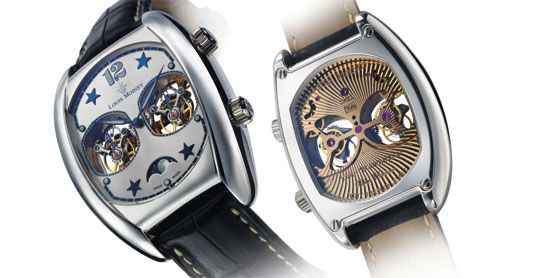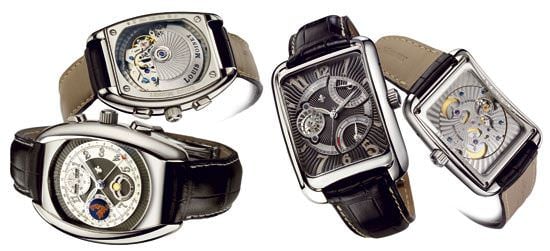This is exemplified by the fact that it was Schaller who orchestrated the rebirth of Perrelet, credited as having been the ‘inventor of the automatic movement’ (despite the fact that this premise is still contested by some historians).
With Louis Moinet, Schaller is approaching timekeeping in a whole different way. Yet, he still remains loyal to his credo, which at the time was innovative and since has been adopted by many others. In other words, he believes in the importance of digging down to the roots of the original name, to its historical context, to find the ‘fundamentals’ that will allow the reju-venated brand to grow and to flourish in a consistent manner.
So, who then was Louis Moinet?

‘Apollo’ Twin tourbillon
An artist and a watchmaker
Jean-Marie Schaller defines Louis Moinet as “the first watch designer.” Born in 1768, Moinet was attracted to an artistic career very early, and went on to learn the art of drawing and painting. But he was also intrigued by watchmaking, and diligently took lessons from a master watchmaker. At age 20, Moinet left France for Rome, Italy, where he studied architecture, painting and sculpture. And, upon his return to Paris in 1795, he became professor of Fine Arts at the Louvre.
During this period, he again began to delve into timekeeping, studying it from both a theoretical and practical standpoint. His ardent interest resulted in his becoming, five years later, the President of the Chronometric Society in Paris in 1800. From then on, he was responsible for several inventions: a new type of balance, a timer, a regulator, and an astronomical watch. He joined forces with Breguet, and collaborated regularly on projects that would, much later, be called ‘design’, specializing most notably in pendulum clocks and dials. In keeping with his Fine Arts background, Moinet also manufactured pendulum clocks that were richly decorated in tune with the taste of the times. Napoleon, Thomas Jefferson, King George IV, James Monroe, etc., were among his most prestigious clients. His works can be found at the Louvre, as well as at Versailles, in the Palazzo Pitti, and at the White House. One last but important detail: in 1848, Louis Moinet published a voluminous Treatise on Timekeeping that would quickly become an indispensable reference for the epoch.

VARIOGRAPH and TWINTECH
The making of a watch brand
Jean-Marie Schaller delved into the various talents of this remarkable individual to provide the ‘legitimacy’ of his new project. “We want to remain faithful to Louis Moinet’s original spirit and to his work that was profoundly watchmaking in nature, while also being impregnated with purely artistic values. In this vein, our movements must be, and are, exceptional. Their decoration and, even more, their veritable creation have equal importance. This is, I believe, what makes our watches so unique.”
Effectively, it is this equilibrium between a certain decorative flamboyance and timekeeping rigour that we find in the creations of the Ateliers Louis Moinet. To these ‘roots’, we can also add another source of inspiration: the Jura, and the exclusive creation of the very lovely ‘Côtes du Jura’. This Jurassian inspiration is also apparent in the network of collaborators that surround the Ateliers Louis Moinet, and which are all located in the Jurassian Arc region.
In terms of movements, most of the Louis Moinet timepieces are equipped with rare vintage calibres. Re-interpreted and re-decorated, they offer original mechanisms. “For the moment,” explains Jean-Marie Schaller, “we are concentrating on the design and the orig-inality of the forms and the decoration of our timepieces. But gradually, we are going to introduce our own movements and mechanisms. This is already the case, for example, with the ‘Twintech’ model, whose double barrel movement (120 hours of power reserve) was created based on a design published by Louis Moinet in 1848. We are also introducing a unique and original piece, called the ‘Apollo’ Double Tourbillon. In addition, we are proposing unique and exclusive mechanisms and indicators, such as the first full moon indicator, which gives the precise indication of the day of the full moon, and the world map, which, with the aid of a small rotating earth, offers a simplified way to tell the time around the world. These two original devices are found in our Variograph model.”
The Ateliers Louis Moinet want to grow in a gradual and organic manner, and is basing its offer on three pillars: first, an entry level line in steel, that is still quite sophisticated (with starting prices of around 10,000 CHF); second, a collection of pieces in gold or other precious metals; and third, a variety of exceptional timepieces.
In carving out its own particular niche, with pieces characterised by the art of watchmaking, but made more ‘dramatic’ by showcasing the brand’s timekeeping values within a framework of adornment and decoration, Louis Moinet hopes its affirmed identity will help create a unique place among the new brands entering the quality segment.
Source: Europa Star February-March 2007 Magazine Issue




